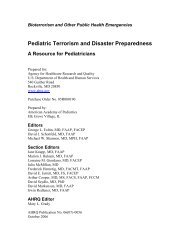(HPP) Performance Measure Manual
(HPP) Performance Measure Manual
(HPP) Performance Measure Manual
You also want an ePaper? Increase the reach of your titles
YUMPU automatically turns print PDFs into web optimized ePapers that Google loves.
APPENDIX A<br />
Appendix A: Glossary<br />
Business continuity: The ability of an organization to provide service and support for its customers and to<br />
maintain its viability before, during, and after a business continuity event.<br />
Chain of command: The orderly line of authority within the ranks of the incident management<br />
organization.<br />
Charter: A written instrument that creates or defines an organization and describes the organization’s<br />
functions.<br />
Common Operating Picture (COP): A common operating picture offers a standard overview of an<br />
incident, thereby providing incident information that enables the Incident Commander or Unified<br />
Command and any supporting agencies and organizations to make effective, consistent, and timely<br />
decisions. Compiling data from multiple sources and disseminating the collaborative information COP<br />
ensures that all responding entities have the same understanding and awareness of incident status and<br />
information when conducting operations. (FEMA Communications and Information Management:<br />
http://www.fema.gov/emergency/nims/CommunicationsInfoMngmnt.shtm)<br />
Continuity of Operations Plans (COOP): A description of how personnel, equipment, and other<br />
governmental, non-governmental, and private resources will support the sustainment and/or<br />
reestablishment of essential functions. Plans shall identify the critical and time sensitive applications,<br />
processes, and functions, to be recovered and continued, following an emergency or disaster, as well as<br />
the personnel and procedures necessary to do so, such as business impact analysis, business continuity<br />
management, vital records preservation and alternate operating facilities. (Reference Target Capabilities<br />
List (TCL) http://www.fema.gov/pdf/government/training/tcl pg. 23)<br />
Crisis Standards of Care: The level of care possible during a crisis or disaster due to limitations in<br />
supplies, staff, environment, or other factors. These standards will usually incorporate the following<br />
principles: (1) prioritize population health rather than individual outcomes; (2) respect ethical principles<br />
of beneficence, stewardship, equity, and trust; (3) modify regulatory requirements to provide liability<br />
protection for healthcare providers making resource allocation decisions; and/or (4) designate a crisis<br />
triage officer and include provisions for palliative care in triage models for scarce resource allocation<br />
(e.g., ventilators) (Chang et al., 2008). Crisis standards of care will usually follow a formal declaration or<br />
recognition by State government during a pervasive (pandemic influenza) or catastrophic (earthquake,<br />
hurricane) disaster which recognizes that contingency surge response strategies (resource-sparing<br />
strategies) have been exhausted, and crisis medical care must be provided for a sustained period of time.<br />
Formal recognition of these austere operating conditions enables specific legal or regulatory powers and<br />
protections for healthcare provider allocation of scarce medical resources and for alternate care facility<br />
operations. Under these conditions, the goal is still to supply the best care possible to each patient.<br />
(Healthcare Preparedness Capabilities)<br />
Critical Infrastructure (CI) and Key Resources (KR): The assets, systems, networks, and functions,<br />
whether physical or organizational, whose destruction or incapacity would have a debilitating impact on<br />
the Nation’s security, public health and safety, and/or economic vitality. (Healthcare Preparedness<br />
Capabilities)<br />
Hospital Preparedness Program (<strong>HPP</strong>) <strong>Performance</strong> <strong>Measure</strong> <strong>Manual</strong><br />
Guidance for Using the New <strong>HPP</strong> <strong>Performance</strong> <strong>Measure</strong>s Page | 56
















